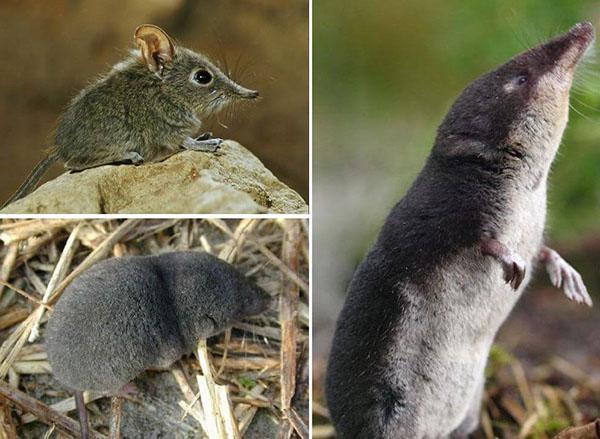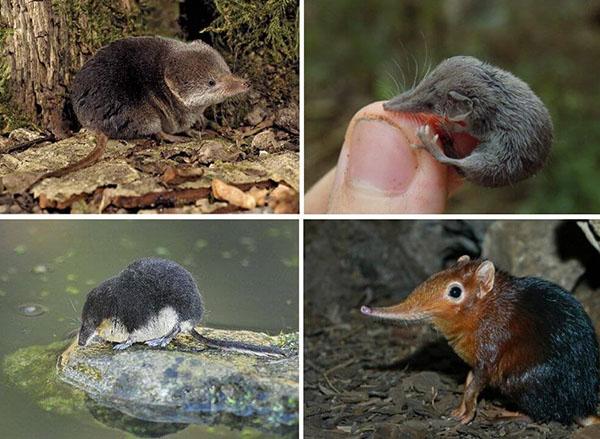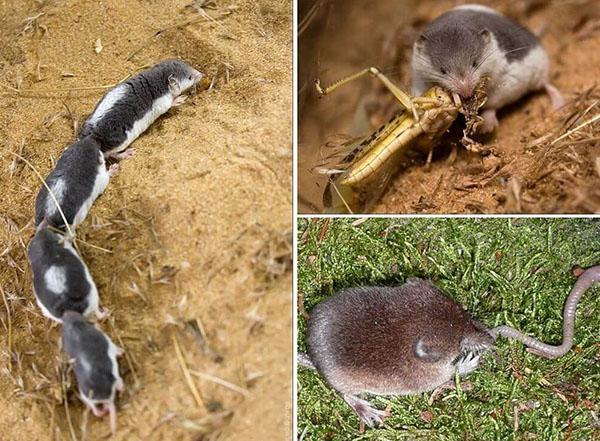How to deal with a shrew in the garden to save the harvest
 Many summer residents are faced with an invisible enemy who, in a short time, is able to shovel an area with crops or vegetables. Wise advice on how to deal with a shrew in your garden will help you deal with this problem. Miniature animals skillfully move in the upper layer of the soil, looking for food for themselves. Therefore, they are not easy to spot. However, there are many modern methods of dealing with annoying pests. But first, let's look at what a shrew looks like and what it eats.
Many summer residents are faced with an invisible enemy who, in a short time, is able to shovel an area with crops or vegetables. Wise advice on how to deal with a shrew in your garden will help you deal with this problem. Miniature animals skillfully move in the upper layer of the soil, looking for food for themselves. Therefore, they are not easy to spot. However, there are many modern methods of dealing with annoying pests. But first, let's look at what a shrew looks like and what it eats.
External features of a miniature animal

However, taking a closer look at it, you can notice a few differences:
- elongated head;
- the nose resembles a trunk;
- fluffy wool;
- a long tail.
There are about 300 species of shrews in nature. The most popular are:
- shrews;
- water;
- shrews;
- elephant.
Most often in the gardens there are shrews, which are considered the smallest among their relatives. The maximum length of the animals barely reaches 5 cm, excluding the tail. And they got their name thanks to the teeth covered with brown enamel. In addition, their wool is brown.
The largest representative of shrews reaches 25 cm (including the tail) in length. Therefore, the animal is sometimes confused with a rat and mercilessly destroyed.
Shrews grow up to 7 cm. Judging by the name, they have white teeth. The wool is dyed gray. The water shrew is found near the banks of rivers and lakes. There are hard membranes on its paws, which help the shrew to move quickly in the water. The body of the animal is covered with waterproof gray wool. However, summer residents are interested in: what the shrew eats when settling in the garden.
Studies have shown that the animal's favorite dish is:
- May beetles;
- caterpillars;
- bear;
- slugs;
- spiders;
- leaf beetles;
- earthworms.
As you can see, the animal destroys potential pests of garden plants. Unfortunately, it loves to feast on plant seeds, grains and horticultural rhizomes. Despite the maximum weight of the shrew - 3.2 g, it has an excellent appetite. In search of food, the animal passes huge tracts of land, leaving behind many holes and passages.
In 24 hours, the mammal eats 4 times more food than it weighs. If he does not have enough food, he attacks small lizards and even his relatives. Sometimes the animal dies of starvation, especially in winter. Despite how long a shrew lives, she raises more than one offspring. The maximum age of the animal is up to 2 years. An adult female brings 3 to 10 babies and first feeds them with milk. Over time, they switch to solid foods. After 21 days, the offspring begins an independent life.
How to deal with a shrew in the garden: expert advice
 When the animal settles in a summer cottage, it immediately starts looking for food. Therefore, many passages and burrows appear on it. In addition, the animal destroys root crops or gnaws at the roots of plants. It often feeds on beneficial insects.
When the animal settles in a summer cottage, it immediately starts looking for food. Therefore, many passages and burrows appear on it. In addition, the animal destroys root crops or gnaws at the roots of plants. It often feeds on beneficial insects.
Although shrews do not harm humans, their presence can destroy crops. Therefore, when animals are found, care should be taken to eliminate them.
The main signs of the "settlement" of shrews at their summer cottage
 Carefully examining their possessions, the summer resident may notice small heaps of loose soil in the garden. The main thing is not to confuse them with "waste heaps" moles or field mice. Usually the animal occupies a plot of land of approximately 50 m² and carefully protects its territory.
Carefully examining their possessions, the summer resident may notice small heaps of loose soil in the garden. The main thing is not to confuse them with "waste heaps" moles or field mice. Usually the animal occupies a plot of land of approximately 50 m² and carefully protects its territory.
Most of them settle in empty mole holes. Although there are those who dig holes on their own. They do not hesitate to live in the hollows of cut trees or under dead wood. They insulate their nests with dry grass and fallen leaves. Some gardeners mistakenly attribute the destruction of cultivated plants to shrews. In fact, the mouse shrew feeds mainly on animal food, which it searches for through its sense of smell.
If there is a greenhouse in the dacha, the animal will definitely visit there and leave traces. If you notice them, you should immediately take action.
However, to determine the presence of shrews, they must be seen. To do this, you will have to be patient and wait. After all, their minks are relatively small. And underground tunnels are barely visible under the soil layer.
Constant helper - chemistry
 Practice shows that it is simply impossible to prevent the appearance of animals on the site. Even tall fences or strong grids are unable to stop the invasion of "underground" neighbors. But how to deal with a shrew in your garden to protect your crop.
Practice shows that it is simply impossible to prevent the appearance of animals on the site. Even tall fences or strong grids are unable to stop the invasion of "underground" neighbors. But how to deal with a shrew in your garden to protect your crop.
Chemicals come to the rescue:
- "Hunter Anti-Rodent". The briquette contains flour, cheese and special substances that lure the rodent.
- "Rat Death". A harsh poison used only as a last resort.
- "Nutcracker". A thick dense substance that is placed near the animal's mink.
Basically, they contain components that affect the respiratory system of animals or cause internal bleeding. After such a meal, the shrews die.
Using more humane methods
 Since the animal brings not only harm, but also benefit to humans, there are other ways of how to deal with a shrew in the garden.
Since the animal brings not only harm, but also benefit to humans, there are other ways of how to deal with a shrew in the garden.
For this, a number of activities are carried out:
- crops with a pungent odor (mint, wormwood, lentils) are planted throughout the territory;
- naphthalene is scattered near the minks, kerosene is poured, or a piece of rotten fish is placed;
- to scare the animals, they use smoke bombs, gas bombs;
- several branches of freshly cut hemp are laid inside the hole, which, when rotting, emits a stench;
- poured with water, diesel fuel or kerosene, minks found in the garden.
Some summer residents make a scarer for shrews with their own hands from improvised items. To do this, use cans or cut plastic bottles. They are placed on a stick, up to 1 m high, so that when the wind gusts, they make violent sounds. Usually, shrews are afraid of unfamiliar noises and leave their "old" territory.
If you wish, you can purchase an ultrasonic device for scaring away animals in the store.
A wonderful way to protect your garden from shrews is to create an underground wall. Sheets of slate or metal are dug into the ground to a depth of 1.5 m along the entire perimeter of the site. As a result, the animals will not be able to enter the new territory from their neighbors.
An equally practical way to escort unexpected guests out of the garden is to plant several beds of onions and winter garlic. The pests do not like the aroma of plants, so they will gradually leave the "inhabited" area. Some gardeners use various traps or traps. The bait is placed there, after which they wait for "their finest hour".
If the animal accidentally climbed into the living room, it is advisable not to touch it. Over time, it will leave the enclosed space, because it is not adapted to this lifestyle.
 Having considered various ways to deal with a shrew in the garden, everyone is free to make their own decisions. Someone will want to get rid of an animal with chemicals. Someone will make a mechanical repeller.Some will want to use folk remedies. In any case, you should take care of animals that do not cause significant harm to people.
Having considered various ways to deal with a shrew in the garden, everyone is free to make their own decisions. Someone will want to get rid of an animal with chemicals. Someone will make a mechanical repeller.Some will want to use folk remedies. In any case, you should take care of animals that do not cause significant harm to people.